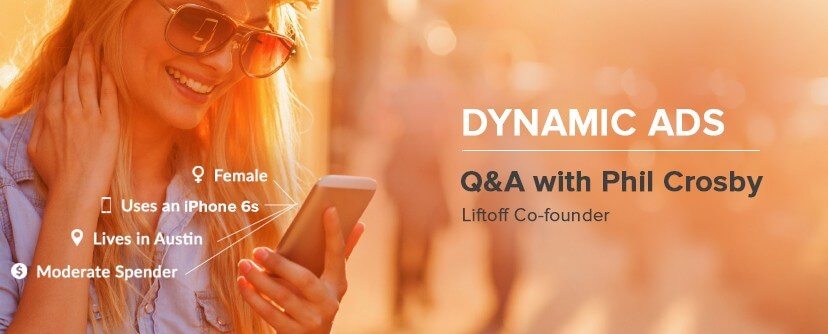
Dynamic Ads and the Future of Mobile Advertising: A Q&A with Liftoff Co-founder Phil Crosby
Earlier this week Liftoff announced the release of our latest product, Dynamic Ads. To get the inside story, we sat down with Liftoff Co-founder and Chief Product Officer, Phil Crosby to get the inside scoop.
Tell us about Dynamic Ads
Dynamic Ads are highly personalized mobile ads, assembled programmatically in real-time. They are personalized using user and device information, allowing us to serve users relevant ads that adopt the look and feel of the device and OS they are displayed on. We render Dynamic Ads in HTML, giving us the ability to serve high definition ads that fit any screen size and device. Because of the level of personalization involved, Dynamic Ads see better post-install conversion rates than static ads.
Where did the inspiration to create dynamic ads come from?
We use machine learning at Liftoff to make decisions about what apps an individual user would prefer and the optimal time to serve them ads for those apps. One day we asked ourselves, “Why don’t we apply that same approach to the actual ad creative?”
Right now, the user experience for 99% of advertising on mobile is pretty generic. The real estate on mobile is limited and most of the messaging about an app’s value proposition falls flat because of how generic it is. But as a user, I want to see compelling ads relevant to me and my interests. There’s a world full of amazing, useful apps out there and I want to know how they’ll improve my life when I see their ads.
So that’s what we set out to do – provide a dramatically better and more personalized creative experience for the end user, which in turn makes conversion rates much higher for the advertiser.
What are the key benefits of Dynamic Ads for mobile marketers?
First and foremost, Dynamic Ads are personalized using demographics, behavioral data, device/OS, and location. For example, for a dating app client we might personalize ads based on location, gender, and age so if a 26 year old male in Chicago sees the ad, he’ll see messaging that says “Looking for singles in Chicago?” with photos of women in his age range. The effects of personalization are tremendous not only for app installs, but post-install engagement. The average advertiser sees a 150-400% increase in post-install conversion rates with Dynamic Ads.
The second major benefit is automatic asset optimization. The way our Dynamic Ads system works is that you simply drop in your assets (e.g. product photos and ad copy), and our system runs continuous A/B tests to determine which assets resonate with which user segments. The system is very efficient and requires no time investment from our advertisers.
What about dynamic ads makes them more effective than static mobile ads?
Dynamic Ads look completely different than a typical static mobile ad because the aesthetics are personalized to the user’s device and OS, giving them a very native look and feel. The ads are built to look beautiful regardless of screen size and have similar positive characteristics of native advertising.
Dynamic Ads look beautiful in any setting, whereas static ads lose a lot of quality when they look out of place. For instance, when you see an ad built for an iPhone 5 on an iPhone 6+, it’s pretty obvious that it doesn’t belong, and the user experience suffers.
Dynamic Ads are also more relevant and interesting, because the content of the ad is personalized based on the characteristics of the user. With static ads, you’re forced to take a “one size fits all” approach to messaging that lacks compelling reasons for quality users to engage with your app.
How are Dynamic Ads different from “dynamic product feed ads”, where product images are dynamically inserted into an ad?
Dynamic Product Feed Ads are a great creative strategy for the retargeting use case, where you target users who have visited your site or used your app before. The limitation is that this is only applicable to your existing user base – users who already have your app or have visited on a product page on your site.
Our Dynamic Ads are a bit different in that we’re able to use them for all users – particularly new users who have never installed your app. The type of personalization is different: Dynamic Ads won’t show the user a specific product they’ve viewed before, but rather a more general product image which will likely appeal to the user based on the data we’ve collected.
How do you see Dynamic Ads evolving in the future?
Dynamic Ads represent a huge opportunity for us to apply machine learning and user data, and honestly, we’re just getting started. Each new advertiser we work with that uses Dynamic Ads unlocks new avenues for us to explore with our product, and the performance gains are usually amazing.
The biggest opportunity for us to evolve Dynamic Ads is to include more dimensions of personalization. As we collect more data, our user profiles get more detailed, which unlocks new data for us to use for Dynamic Ad personalization. For example, if we are able to increase our coverage of a user’s location history, then we can algorithmically work out whether they’re at home, school or work and use that as a new signal for personalizing ad creatives.
Learn more about how Dynamic Ads can help you increase post-install conversions by 400%.